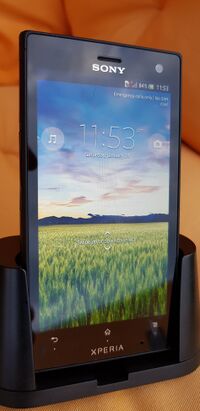Sony Xperia acro S (sony-hikari): Difference between revisions
m Intgr moved page Sony Xperia acro S (semc-hikari) to Sony Xperia acro S (sony-hikari) over redirect: The device is more commonly known as "Sony" instead of "SEMC". There's no mention on Ericsson on the device, only the logo remains on the back. |
m originalversion |
||
| (8 intermediate revisions by 6 users not shown) | |||
| Line 1: | Line 1: | ||
{{Infobox device | {{Infobox device | ||
| manufacturer = Sony | | manufacturer = Sony | ||
| name = Xperia acro S | | name = Xperia acro S (LT26w) | ||
| codename = hikari | | codename = sony-hikari | ||
| image = File:Sony Xperia acro S.jpg | | image = File:Sony Xperia acro S.jpg | ||
| imagecaption = Sony Xperia acro S with its included dock | | imagecaption = Sony Xperia acro S with its included dock | ||
| releaseyear = 2012 | | releaseyear = 2012 | ||
| originalsoftware = Android 4.0 ( | | originalsoftware = Android | ||
| chipset = Qualcomm | | originalversion = 4.0 (Linux 3.4.0) | ||
| cpu = 1.5 GHz Scorpion | | chipset = Qualcomm Snapdragon S3 (MSM8260) | ||
| cpu = 2x 1.5 GHz Scorpion | |||
| gpu = Adreno 220 | | gpu = Adreno 220 | ||
| storage = 16 GB | | storage = 16 GB | ||
| display = 720 x 1280 | | display = 720 x 1280 | ||
| memory = 1 GB | | memory = 1 GB | ||
| architecture = | | architecture = armv7 | ||
| status_usbnet = | | status_usbnet = | ||
| status_flashing = | | status_flashing = | ||
| Line 37: | Line 38: | ||
== Contributors == | == Contributors == | ||
* intgr | * [[User:Intgr|intgr]] | ||
== What works == | == What works == | ||
| Line 49: | Line 46: | ||
boot.img: ELF 32-bit LSB executable, ARM, version 1 (ARM), statically linked, corrupted section header size | boot.img: ELF 32-bit LSB executable, ARM, version 1 (ARM), statically linked, corrupted section header size | ||
intgr has a working hacked postmarketOS toolchain for building compatible boot.img files. | [[User:Intgr|intgr]] has a working hacked postmarketOS toolchain for building compatible boot.img files. | ||
== What does not work == | == What does not work == | ||
| Line 58: | Line 55: | ||
After trying out tens of different combinations of kernel sources from the web, I couldn't find any that get as far as initramfs. | After trying out tens of different combinations of kernel sources from the web, I couldn't find any that get as far as initramfs. | ||
The best sources found manage to initialize the display backlight and then [https:// | The best sources found manage to initialize the display backlight and then crash pretty late in the initialization process with error: [https://gist.github.com/intgr/0aea53457cc7ae4edfaa01cf50807cb7 (see dmesg)] | ||
BUG: Bad page state in process swapper/0 pfn:5dcba | BUG: Bad page state in process swapper/0 pfn:5dcba | ||
| Line 65: | Line 62: | ||
==== Mainline kernel ==== | ==== Mainline kernel ==== | ||
No peripherals supported yet, but | No peripherals supported yet, but <code>/dev/last_kmsg</code> can be extracted with a binary kernel (e.g. TWRP). Sadly the boot process appears to hang after executing <code>/init</code>: [https://gist.github.com/intgr/cc5b4e606846e33d6415694084f4aba1 (see dmesg)] | ||
WIP can be seen here: https://gitlab.com/intgr/linux-postmarketos/compare/master...device-sony-hikari | WIP can be seen here: https://gitlab.com/intgr/linux-postmarketos/compare/master...device-sony-hikari | ||
| Line 75: | Line 72: | ||
== Installation == | == Installation == | ||
Follow [https://developer.sony.com/develop/open-devices/get-started/unlock-bootloader Sony's instructions to unlock the bootloader]. | Follow [https://developer.sony.com/develop/open-devices/get-started/unlock-bootloader Sony's instructions to unlock the bootloader]. | ||
Latest revision as of 04:34, 24 October 2023
Status: Uses unusual ELF-format boot.img that is not supported by pmOS
 Sony Xperia acro S with its included dock | |
| Manufacturer | Sony |
|---|---|
| Name | Xperia acro S (LT26w) |
| Codename | sony-hikari |
| Released | 2012 |
| Hardware | |
| Chipset | Qualcomm Snapdragon S3 (MSM8260) |
| CPU | 2x 1.5 GHz Scorpion |
| GPU | Adreno 220 |
| Display | 720 x 1280 |
| Storage | 16 GB |
| Memory | 1 GB |
| Architecture | armv7 |
| Software | |
| Original software | Android |
| Original version | 4.0 (Linux 3.4.0) |
| postmarketOS | |
| Category | testing |
| Pre-built images | no |
Contributors
What works
This device uses a non-standard ELF format boot.img file that is not supported by postmarketOS (yet):
% file boot.img boot.img: ELF 32-bit LSB executable, ARM, version 1 (ARM), statically linked, corrupted section header size
intgr has a working hacked postmarketOS toolchain for building compatible boot.img files.
What does not work
Booting.
Downstream kernels
After trying out tens of different combinations of kernel sources from the web, I couldn't find any that get as far as initramfs.
The best sources found manage to initialize the display backlight and then crash pretty late in the initialization process with error: (see dmesg)
BUG: Bad page state in process swapper/0 pfn:5dcba
WIP can be seen here: https://gitlab.com/intgr/pmaports/compare/master...device-sony-hikari
Mainline kernel
No peripherals supported yet, but /dev/last_kmsg can be extracted with a binary kernel (e.g. TWRP). Sadly the boot process appears to hang after executing /init: (see dmesg)
WIP can be seen here: https://gitlab.com/intgr/linux-postmarketos/compare/master...device-sony-hikari
How to enter flash mode
Power off the device. Hold Volume Up as you plug the USB cable into the device.
Alternatively, perform a hard reset by holding Power and Volume Up buttons. When the device vibrates, release the Power button *first*, and it will boot into fastboot loader.